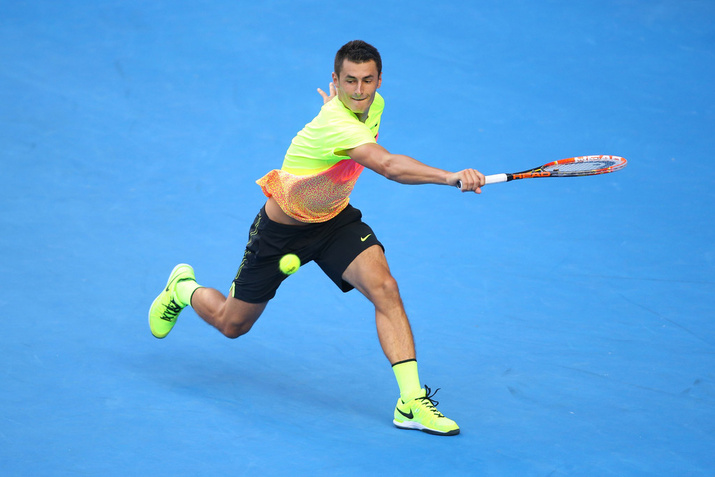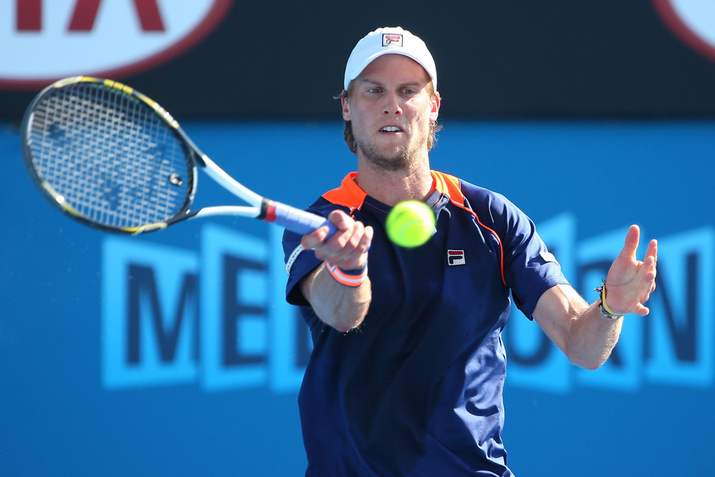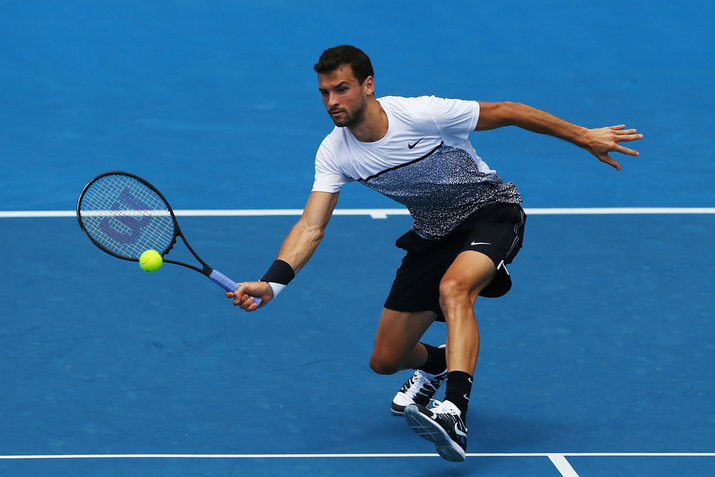Don't miss any stories → Follow Tennis View
FollowBest of Five: ATP Bottom-Half Highlights from First Week
In a companion piece to the earlier article, this recap of the five best matches in the bottom half of the Australian Open men’s draw features Roger Federer, Bernard Tomic, and Thanasi Kokkinakis.

5) R2: Bernard Tomic d. Philipp Kohlschreiber 6-7(5) 6-4 7-6(6) 7-6(5)
In a match that featured plenty of highlights and talented shot-making. Bernie and Peppo brought their best tennis to this round two clash. It was Tomic who drove the partisan home crowd into a frenzy with a four-set victory. Kohlschreiber was flummoxing Tomic at times in this match, including in the first-set tiebreak, and according to Tomic in a post-match interview, “He was coming up with shots I’ve never seen before. Some shots, I don’t know how they were going in.”
However, Tomic kept his focus against the relentless shot-making assault of the German and played some great shots himself. All the tiebreaks were close, and Tomic took control of the match by serving up an ace on set point at 7-6 in the third-set tiebreak. It is always enjoyable to watch a contest where both players are bringing their best tennis to bear, and the stats back up how aesthetically pleasing this match was. Kohlschreiber had a 67/40 winners/unforced errors ratio, and Tomic was 67/46. He also pounded out 23 aces. Neither player was particularly adept at converting break points, Tomic going 2/8 and Kohlschreiber going 1/6.
With just a few points in the tiebreaks ending differently, the result could have been the opposite. It will be interesting to see what 2015 brings for Tomic. Without the pressure of being the “top Aussie young gun” anymore, he’s playing looser and fighting harder than he used to.
4) R1: Thanasi Kokkinakis d. Ernests Gulbis 5-7 6-0 1-6 7-6(2) 8-6
This was a very low quality contest until the fourth-set tiebreak. Gulbis took the first set with Kokkinakis playing quite poorly and then promptly tanked set two. Kokkinakis likewise couldn’t keep his momentum going after taking a set and quickly lost the third set with his shots going all over the place. In the fourth set, most people figured Kokkinakis was ready to hit the showers, but when he went match point down four times in that fourth set, he stiffened up and started playing his best tennis of the match. He primarily relied on his forehand to save the day and keep the match alive. With the crowd believing in the Aussie young gun, he took that momentum into the fifth set after powering through a fourth-set tiebreak. He fended off break-point chances for Gulbis at both 4-4 and 6-6 before holding for 7-6 and breaking in the next game to take out the top-15 Gulbis, who played as poorly as he often does in Australia.
It’s unlikely Kokkinakis would have been able to gut it out without the crowd backing him and messing with Gulbis at the same time. That’s part of what makes the Australian Open so great. The final two sets of this match were Grand Slam tennis in the early rounds at its best, as a young challenger took out an established star player on home soil. Kokkinakis, who nearly had as many double faults as he had aces, won eight fewer total points than Gulbis and had 31 fewer winners. He has a promising future ahead, and his break point conversion rate was the difference. He went 7/13, while Gulbis was just 7/21, not taking advantage of the chances he had.

3) R3: Andreas Seppi d. Roger Federer 6-4 7-6(5) 4-6 7-6(5)
Andreas Seppi has already posted better results in the first month of 2015 than he did in all of 2014. The Italian veteran appears revitalized, and he played the match of his life to take out Federer in four sets. This shocking loss for Federer is the biggest upset of the tournament thus far, and it took Seppi playing a flawless performance to pull it off. He played reliable and efficient baseliner tennis, controlling enough of the rallies to win without being pressured too much on his serve. (Federer was just 3/10 on break points in the match.) The counterpunching Italian came forward and hit with power when needed, and on match point in the fourth-set tiebreak, with many having already written him off by the time it got to that stage, he hit what is sure to be one of the shots of the year. Seppi looped a passing shot just past Federer that landed on the line by the narrowest of margins. As the commentators on Eurosport stated, his winner on match point was a one in 100 type of shot.
For his part, Federer played very poorly. His shots lacked depth, he was not going for the lines, and he seemed to be massaging the ball, playing tentative tennis. He appeared to be limp-wristed and was looking at his wrist throughout the match. Seppi was allowed to dictate the flow of the match, and Federer couldn’t conjure up aggressive shots often enough to pull off the comeback.
2) R2: Rafael Nadal d. Tim Smyczek 6-2 3-6 6-7(2) 6-3 7-5
Smyczek would probably be the first to admit this match never would have been what it was if Nadal had not gotten dizzy and sick to his stomach in the middle of it. That said, much respect to the American journeyman for hanging in it until the end and never fading. Nadal was a set and a break up in the first part of the match but proceeded to fall apart in the middle of it. Smyczek’s retrieval style of tennis was reliable enough for him to grab the second set, and then an 81-minute third set as he played a masterful tiebreak. Nadal wasn’t giving near 100% for large parts of this match, and he selectively chose to raise his level on pressure points. That approach finally paid off for him in sets four and five, as he broke Smyczek a lone time in set four and then once out of four chances (at 5-5) in set five to win. Smyczek had a positive winners/unforced errors ratio in every set after the first and really did push himself to the limit. In addition, everyone commended his sportsmanship gesture at 5-6 in the fifth set, when he gave Nadal another first-serve chance due to fan interference. Smyczek is one of the nicest guys in the sport, and it was fun to watch him truly enjoy himself out there and go toe to toe with the big guns of the sport. Nadal recovered at the right time, but Smyczek gave the match his all.
Hopefully this confident performance will power Smyczek to a career year in 2015, while Nadal yet again showed his fighting spiGirrit and kept himself alive in the tournament while ill.

1) R3: Grigor Dimitrov d. Marcos Baghdatis 4-6 6-3 3-6 6-3 6-3
Some great shot-making took place in this battle. Marcos Baghdatis turned back the clock, as the rather washed-up former Australian Open finalist of nine years ago gave top-15 player Grigor Dimitrov all he could handle under the Melbourne sun, with his rowdy Greek/Cypriot fans into it the entire match. Every set featured a break of serve, since Baghdatis was firing winners and powerful groundstrokes on both wings, and Dimitrov was troubled for much of the match with the aggression of Baghdatis, along with the spin of his shots. Dimitrov at times had to resort to moonballing, and he played large parts of this match behind the baseline and on his back foot. They went back and forth for four even sets of rallying, and then Dimitrov went 2/5 on break points in the fifth set to take it. Baghdatis failed to generate a single break point chance in any of the three sets he lost, and that was the difference. Despite all the highlights he produced, and even though his game plan was working, he couldn’t keep it up long enough and consistently enough to get past Dimitrov.
Over time, the rallies shifted in Dimitrov’s direction, and he very well could have taken the third set, but he went 0/6 on break point chances. Both players were great at net, winning over 70% of their net point opportunities, and Baghdatis showed he can still produce a clinic in attacking tennis and make memorable Grand Slam moments. It was a good tournament for him to reach the third round, while Dimitrov is still looking to rise to the level he’s truly capable of.










